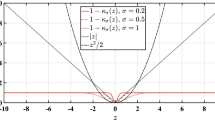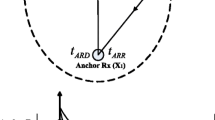Abstract
To address the problem of low indoor positioning accuracy in time-of-arrival systems in the non-line-of-sight (NLOS) environments, we proposed an optimized positioning algorithm based on semidefinite programming (SDP). This algorithm reduces the NLOS error through a novelty method. Compared with the original SDP algorithm, we optimized the algorithm’s objective function by avoiding its dependence on the prior information, thereby decreasing infeasibility problems. The experiment showed that the proposed algorithm’s accuracy is superior to that of the traditional SDP algorithm in the same indoor environment.








Similar content being viewed by others
References
Jang, B., Kim, H., & Kim, J. (2022). Survey of landmark-based indoor positioning technologies. Information Fusion, 89, 166–188.
Shang, S., & Wang, L. (2022). Overview of WiFi fingerprinting-based indoor positioning. IET Communications, 16(7), 725–733.
Farahsari, P. S., Farahzadi, A., Rezazadeh, J., & Bagheri, A. (2022). A survey on indoor positioning systems for IoT-based applications. IEEE Internet of Things Journal, 9(10), 7680–7699.
Bencak, P., Hercog, D., & Lerher, T. (2022). Indoor positioning system based on bluetooth low energy technology and a nature-inspired optimization algorithm. Electronics, 11(3), 308.
Wandell, R., Shafaeat, H. M., & Hussain, I. (2023). A cost-effective Wi-Fi-based indoor positioning system for mobile phones. Wireless Networks, 29, 1–18.
Shen, G., Zetik, R., & Thoma, R.S. (2008). Performance comparison of TOA and TDOA based location estimation algorithms in LOS environment. In 2008 5th workshop on positioning, navigation and communication (pp. 71–78). IEEE.
Sakaguchi, K., Hai, Y.-E., & Araki, K. (2005). MIMO channel capacity in an indoor line-of-sight (LOS) environment. IEICE Transactions on Communications, 88(7), 3010–3019.
Djosic, S., Stojanovic, I., Jovanovic, M., & Djordjevic, G. L. (2022). Multi-algorithm UWB-based localization method for mixed LOS/NLOS environments. Computer Communications, 181, 365–373.
Sun, M., Yunjia Wang, L., Huang, S. X., Cao, H., Joseph, W., & Plets, D. (2022). Simultaneous WiFi ranging compensation and localization for indoor NLOS environments. IEEE Communications Letters, 26(9), 2052–2056.
Wang, F., Tang, H., & Chen, J. (2023). Survey on NLOS identification and error mitigation for UWB indoor positioning. Electronics, 12(7), 1678.
Kim, J. (2023). Suppression of NLOS errors in TDOA-AOA hybrid localization. Wireless Networks, 29(2), 657–667.
Tian, X., Wei, G., Song, Y., & Ding, D. (2023). Cooperative localization based on semidefinite relaxation in wireless sensor networks under non-line-of-sight propagation. Wireless Networks, 29(2), 775–785.
Luo, Q., Yang, K., Yan, X., Li, J., Wang, C., & Zhou, Z. (2022). An improved trilateration positioning algorithm with anchor node combination and k-means clustering. Sensors, 22(16), 6085.
Guo, J., & Tao, H. (2021). Cramer-Rao lower bounds of target positioning estimate in netted radar system. Digital Signal Processing, 118, 103222.
Yan, W., Jin, D., Lin, Z., & Yin, F. (2021). Graph neural network for large-scale network localization. In ICASSP 2021–2021 IEEE international conference on acoustics, speech and signal processing (ICASSP) (pp. 5250–5254). IEEE.
Liu, G., Hua, J., Li, Feng, L., Weidang, & Xu, Z. (2020). A quadratic programming localization based on TDOA measurement. In Communications, signal processing, and systems: proceedings of the 2018 CSPS Volume II: signal processing 7th (pp. 1243–1250). Springer.
Zou, Y., & Liu, H. (2020). An efficient NLOS errors mitigation algorithm for TOA-based localization. Sensors, 20(5), 1403.
Katwe, M., Ghare, P., Sharma, P. K., & Kothari, A. (2020). NLOS error mitigation in hybrid RSS-TOA-based localization through semi-definite relaxation. IEEE Communications Letters, 24(12), 2761–2765.
Ding, W., Zhong, Q., Wang, Y., Guan, C., & Fang, B. (2022). Target localization in wireless sensor networks based on received signal strength and convex relaxation. Sensors, 22(3), 733.
Chen, P-C. (1999). A non-line-of-sight error mitigation algorithm in location estimation. In WCNC. 1999 IEEE wireless communications and networking conference (Cat. No. 99TH8466) (Vol. 1, pp. 316–320). IEEE.
Li, Y., Gao, Z., Qiaozhuang, X., & Yang, C. (2023). Comprehensive evaluations of NLOS and linearization errors on UWB positioning. Applied Sciences, 13(10), 6187.
Su, Z., Shao, G., & Liu, H. (2016). A soft-minimum method for NLOS error mitigation in TOA systems. In 2016 IEEE 84th vehicular technology conference (VTC-Fall) (pp. 1–4). IEEE.
Feng, Z., Wang, B., Zhao, Y., Luan, M., & Fengye, H. (2021). Power optimization for target localization with reconfigurable intelligent surfaces. Signal Processing, 189, 108252.
Zhenqiang, S., Shao, G., & Liu, H. (2017). Semidefinite programming for NLOS error mitigation in TDOA localization. IEEE Communications Letters, 22(7), 1430–1433.
Jiang, H., Kathuria, T., Lee, Y.T., Padmanabhan, S., & Song, Z. (2020). A faster interior point method for semidefinite programming. In 2020 IEEE 61st Annual Symposium on foundations of computer science (FOCS) (pp. 910–918). IEEE.
Vaghefi, R. M., Schloemann, J, & Michael Buehrer, R. (2013). Nlos mitigation in toa-based localization using semidefinite programming. In 2013 10th workshop on positioning, navigation and communication (WPNC) (pp. 1–6). IEEE.
Boyd, S. P., & Vandenberghe, L. (2004). Convex optimization. Cambridge University Press.
Shafira, T., Chaerani, D., & Lesmana, E. (2020). Robust optimization model for truss topology design problem using convex programming CVX. World Scientific News, 148, 27–45.
Funding
The project is supported in part by the National Natural Science Foundation under grant (\(\mathrm {No.}\) 62371248). It is also supported by the foundation of reform project of graduate teaching in Nanjing University of Posts and Telecommunications (\(\mathrm {No.}\) JGKT22_XYB03).
Author information
Authors and Affiliations
Corresponding author
Additional information
Publisher's Note
Springer Nature remains neutral with regard to jurisdictional claims in published maps and institutional affiliations.
Rights and permissions
Springer Nature or its licensor (e.g. a society or other partner) holds exclusive rights to this article under a publishing agreement with the author(s) or other rightsholder(s); author self-archiving of the accepted manuscript version of this article is solely governed by the terms of such publishing agreement and applicable law.
About this article
Cite this article
Chen, Y., Wang, W., Wu, H. et al. NLOS error mitigation in TOA systems. Wireless Netw (2024). https://doi.org/10.1007/s11276-024-03702-8
Accepted:
Published:
DOI: https://doi.org/10.1007/s11276-024-03702-8




